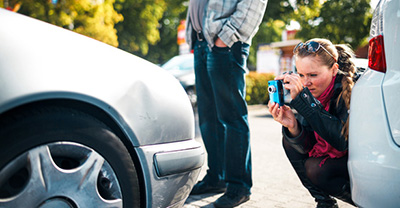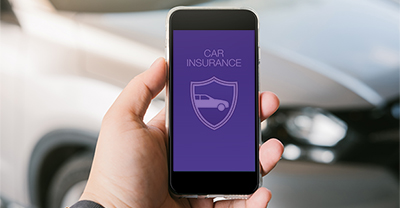What is “full coverage” car insurance?


0 min. read
What is “full coverage” insurance?
“Full coverage” car insurance refers to an insurance policy that offers coverage above the minimum legal requirements the law requires of you and your vehicle. While not an actual insurance product, this term usually refers to the combination of liability, collision, and comprehensive insurance.
Like the name suggests, having a “full coverage” car insurance policy should mean you’re fully covered in all situations, but that’s not always the case. Your agent can help advise you on what exactly you can purchase if you’re looking for “full coverage.” Explore Dairyland’s cheap car insurance options to find the coverage that fits your lifestyle and budget.
To find the best auto insurance policy to help cover you and your vehicle more fully, you should follow three simple steps when shopping for insurance:
Understand what coverages you’re required to carry in your state
Review your additional coverage options
Make selections based on your unique needs and budget

Car insurance coverage options
There are many types of insurance coverages you can choose to include in your auto insurance policy.
Required and optional car insurance coverages
Coverage | Description |
|---|---|
Liability coverage | This type of insurance helps cover the medical and damage costs for another driver in an accident where you're deemed to be at fault. Liability insurance is required by most states. For example, if you rear-end another car and you’re at fault, bodily injury liability insurance can help pay for the other driver’s medical expenses, and property damage liability can help pay for repair costs they incur because of that accident—up to the amount provided by your insurance policy. |
Uninsured and underinsured motorist coverage | If you're in an accident and the at-fault driver doesn't have any or enough insurance, uninsured or underinsured motorist coverage—if available in your state—may help pay for damage to your vehicle and potential medical costs that resulted from the accident. Many states require this coverage to be offered but allow the policyholder to opt out or reject this coverage in writing. |
Personal injury protection (PIP) and medical payments | These coverages can help pay medical expenses for injuries to the driver and passengers in your vehicle, regardless of who is at fault in an accident. Personal injury protection and medical payments coverage aren't available in all states, so check with your insurer or agent to see if you're eligible to add them to your policy. |
Coverages to help protect vehicles
Coverage | Description |
|---|---|
Collision and comprehensive coverages | These two insurance coverages are typically purchased together because collision insurance helps pay for repairs to your vehicle if you hit an object like a fence or another car, and comprehensive insurance covers damage caused by forces commonly outside of your control like weather or theft. These coverages combined may help with most kinds of accidental damage to your car. |
Special equipment coverage | If you've added special touches or improvements to make your car your own, you may want to make sure they're protected. If you're in an accident, special equipment coverage may help pay to replace those special touches such as custom rims, spoilers, stereo systems, and more. |
Coverage options to help with fees and loans
Coverage | Description |
|---|---|
Towing and labor coverage | You never know when or where your car might break down, causing the need for a tow truck to take your vehicle to the nearest service station. Towing and labor coverage will help pay for the towing and labor fees in case your car leaves you stranded. |
Rental reimbursement coverage | If your car needs to be repaired or replaced due to a covered loss, you may need a temporary car to get you around. Rental reimbursement coverage can help pay for a rental vehicle so you can still get to work on time. |
Lienholder coverage options | If you're planning to lease or buy a car and you're paying for it with a bank loan, the lender may require you to hold coverages like gap or car loan protection insurance. These coverages can help guarantee a certain level of insurance to pay off the loan if an accident occurs while you're still making payments. |
How much does “full coverage” car insurance cost?
The premium for a "full coverage" offering—which, as noted above, isn't actually a type of policy or coverage, but rather a combination of several coverages—can vary based on different factors:
Coverage selection
The price of your premium will vary depending on which coverages you add to your policy. One person may consider three types of coverage to be “full coverage”, while another person may consider five types of coverage to be “full coverage”. Either way, it's important to remember that "full coverage" doesn't actually exist as a type of auto insurance.
The more coverages and higher limits you include in your car insurance policy, the greater up-front costs you’ll have. However, your car insurance payments are much less than the life-altering debt one can accrue from an accident where you didn’t have enough insurance.
Coverage limits
The maximum amount your car insurance will pay out for a covered claim is called a limit. Choosing higher or lower limits on your coverage selections can impact the rates you pay. Setting higher limits will typically cause you to pay higher premiums.
Driving record
The type of driver you are can also influence your costs. If you've never been in an accident or had a ticket, you will typically pay less for insurance than someone who has caused an accident or has tickets on their driving record.
What to consider when selecting “full coverage” insurance
Because you can't pick a one-size-fits-all package for “full coverage” insurance, it's important to think about your specific needs when determining which coverages will work best together to protect you and your vehicle.
Here are some things to consider as you make your coverage selections:
Potential injuries from accidents
Costs associated with injuries can be life-altering. When reviewing your coverage options, be sure you understand who and what is covered, and under what circumstances.
For example, “full coverage” is considered the combination of liability, comprehensive, and collision. What's crucial to note is that liability coverage helps with injuries to the other person when you cause an accident.
What happens if you're also injured in the accident? Or, what if someone hits you and they don't have any car insurance to help cover your injuries?
Be sure to review additional coverage options like uninsured, underinsured, medical expenses, and more to help ensure everyone's injuries are covered in an accident, regardless of who caused it.
Your vehicle
Several factors regarding the vehicle you drive can help determine the types of coverages you'll want or, in some cases, be required to purchase.
Leased or financed vehicle
If you're borrowing money to purchase a car or leasing a vehicle, the lender/leaser typically requires you to purchase specific coverages for your car insurance. The lender/lease agreement will include your needed coverage details.
Rental
As you make your coverage selections, you might wonder about rental vehicles and rental reimbursement:
Does “full coverage” insurance cover a rental car?
In most cases, if you file a covered claim under your comprehensive and collision coverage, your car insurance may help cover damages to your rental car. However, you should check with your insurance carrier before declining coverage offered by the rental agency.
Is rental reimbursement coverage worth it?
If you drive frequently—like a daily commute—it may be worth looking at. Especially if you don't want to risk the cost of a long-term rental if your car ends up being in the shop for a covered claim.
Be aware that some insurers require policyholders to carry collision and comprehensive before having the option to add rental reimbursement coverage.
Vehicle age
The older your car is, the less likely you'll want to pay for extra coverages like comprehensive or collision, so “full coverage” might not be right for you in this case. Why? Over time your car's value depreciates and what you'd receive from insurance after you pay your deductible might not be worth the cost of the coverage.
In the case of a newer car—which naturally has a higher value—added coverages could be worth the additional cost. For most people, replacing a new vehicle at a high cost is much more difficult to do out-of-pocket than to pay a deductible and have the additional costs covered by insurance.
Custom parts
If you're concerned about the type of replacement parts your car could receive when being repaired after a crash, it's worth reviewing special equipment coverage as a part of your “full coverage” package.
Consider the amount of investment you made in your vehicle's customization to help determine if this added insurance is worth it for you.
Roadside inconveniences
Are you driving an unreliable vehicle? If so, roadside assistance coverage could be a worthwhile expense. Keep in mind that some providers only offer this after you've added comprehensive and collision to your policy.
Types of damages that can occur
Be sure to consider the ways in which your car could be damaged and which coverages can help pay for each of the damage types as you look at your coverage options.
Collisions
There are several coverage types that can help with costs related to vehicle damage from a collision with another car or an object like a tree:
Property damage liability: This coverage is typically required and covers the other person's property when you're at fault in an accident.
Collision coverage: Can help cover the cost of damage to your vehicle if you hit a stationary object or another car, regardless who's at fault.
Uninsured/underinsured property damage (not available in every state): These coverages help pay for damages to your car when someone who doesn't have enough (or any) insurance hits you and they're found to be at fault.
Each of these coverages help you in different scenarios involving collision damage to vehicles. Naturally, a combination of these coverages can help to better protect your vehicle and others' in almost any collision accident.
Forces of nature
You may want to buy coverage that helps with car damages beyond your control (unrelated to an accident with another vehicle/object). Here are some causes for this type of damage:
Animals
Theft
Weather
Vandalism
This coverage is comprehensive car insurance and as one of the typical coverages included under “full coverage” car insurance, it helps ensure your car is protected from all types of damage when purchased in conjunction with collision and other coverages.
Note that if you're leasing a car or borrowing money to buy one, your lender/leaser will require you to purchase comprehensive and collision in most cases. Additionally, to qualify for other insurance coverages like towing and labor, your insurer could require a purchase of these two coverages as well.
Your budget
When it comes down to it, your determination of what “full coverage” means for you is going to be influenced by what you can afford. Once you know what insurance is required for you, look at the coverages you feel are most crucial to meet your needs. Then, start getting quotes to find the best insurance at the price you want to pay.

Where do I find cheap “full coverage” car insurance?
Because "full coverage" isn't actually a type of policy or coverage, insurance providers obviously won't have a set price for it. And anyway, finding the cheapest car insurance may be desired, but price shouldn't be the only factor when it comes to your safety on the road. When shopping for an insurance provider, consider the following:
Reliability: Are the potential insurer's reviews good? Are they a financially stable company?
Claims process: What is the insurer's reputation for handling claims?
Customer service: Is someone available to answer a phone to help you?
Convenience: Are you able to get a quote or access account information online?
Our customer service team is available 24/7 to serve you. Not a customer yet? Give us a call now at 888-344-4357 to see what we can offer you. If you prefer online quotes, we've got you covered there too:

“Full coverage” car insurance FAQs
Do I need “full coverage” car insurance?
Remember, "full coverage" car insurance doesn't actually exist as a policy or coverage type. It's just a term for a combination of coverages, and you're not legally required to carry more insurance beyond your state's minimum requirements.
However, if you want to do your best to protect your property and minimize medical expenses in the event of an accident—no matter who's at fault—it's a good idea to purchase additional coverage. And, if you lease a car or buy a car using a loan, additional coverage may be required by the leaser or lender.
What does “full coverage” usually cover?
"Full coverage" isn't a type of coverage or policy, so it doesn't actually cover anything on its own. It typically refers to liability insurance, collision insurance, comprehensive insurance, and any other coverages you and your insurance provider decide to add to your policy.
Having all these coverages can help keep you protected in a wide range of scenarios, whether your car is stolen or you hit a deer. Even if you’re found to be at fault in an accident, your auto insurance will have your back and help cover costs of damage and medical expenses.
What’s the difference between liability and “full coverage”?
Liability-only car insurance policies are typically made up of bodily injury and property damage coverages, and possibly a few other liability coverages. In many states, these are the only coverages you need to legally operate a vehicle—but they won’t help pay for your own expenses if you’re injured or your vehicle is damaged in an accident.
That’s where the coverages often included in “full coverage” policies—such as collision, comprehensive, and personal injury protection (PIP)—can be worth carrying, even though your premiums will be a little higher compared to a liability-only policy.
Learn more about the differences between liability and “full coverage” car insurance.
Is anything not covered by “full coverage” car insurance?
Since “full coverage” isn’t a type of insurance, you get to decide which coverages and limits you purchase. You can add as many or as few types of comprehensive, collision, and liability insurance beyond the minimum requirements to your policy for it to meet your definition of “full coverage”. If you’re still not sure, give us a call and we can provide more detailed information.
Is comprehensive insurance “full coverage?”
No, comprehensive car insurance and “full coverage” car insurance aren’t the same thing. The confusion is understandable, though, since “comprehensive” is often used as a synonym for “complete.”
But when it comes to car insurance, comprehensive refers to a specific type of coverage that can help pay for repairs if your vehicle is damaged by something other than a collision, such as theft, vandalism, animal encounters, and certain weather events. “Full coverage,” meanwhile, is a term often used to describe car insurance policies that include liability, collision, and comprehensive coverages.

The general information in this blog is for informational or entertainment purposes only. View our blog disclaimer.
*Data accuracy is subject to this article's publication date.










